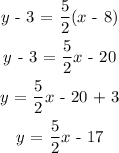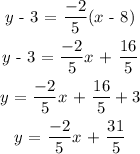Answer:
The equation parallel to the given equation and passing through the point (8, 3) is:

The equation perpendicular to the given equation and passing through the point (8, 3) is:

Explanations:
The equation of the line parallel to the line y = mx + c and passing through the point (x₁, y₁) is given as:

The equation of the line perpendicular to the line y = mx + c and passing through the point (x₁, y₁) is given as:

Now, for the equation:

The line parallel to the equation and passing through the point (8, 3) will be:

The line perpendicular to the given equation and passing through the point (8, 3) will be:
